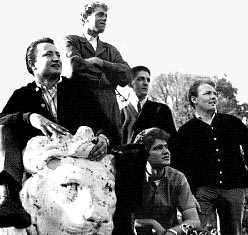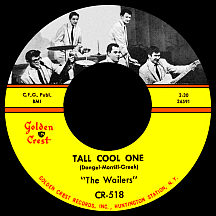THE WAILERS
Tall Cool One
Tacoma, Washington didn't have much of a late-'50s rock and roll "scene" like the larger cities. Seattle (30 miles north) and Portland, Oregon (150 miles south) were much more vibrant, or so John Greek figured; Tacoma was, after all, best known for being the home of the world's foremost crooner, Bing Crosby. Not that the top stars of the time didn't perform there. Jazz and blues musicians from all over the U.S. regularly made the trek to the Seattle area, and the example set by these types of artists was what John's band The Wailers built its sound on. The guys in the group dug deeper than radio hits and American Bandstand singers for inspiration, tuning in distant stations from surrounding states late at night, some of them emphasizing rhythm and blues. On weekends they searched area record shops for little-known gems, discovering some of their favorites in the jazz bins. Observing the blues musicians who played small clubs in the area provided pointers on how to execute some crowd-pleasing riffs.
Rhythm guitarist Greek and his bandmates were all teenagers, so a certain amount of sneaky behavior went with the territory, at least until they were better established. Instrumentals were their primary poison: Richard Dangel was lead guitarist, Kent Morrill covered the keyboards, Mark Marush blew a strong tenor sax and Mike Burk often took an unusual rhythmic approach to playing drums; the five didn't feel the need for a bassist! In late 1958, after rejections from several record labels, John got to know local musician and songwriter Attilio Mineo (who made records as Art Mineo and later composed outer space-themed music for the 1962 Seattle World's Fair) and he put in a good word with Clark Galehouse, the owner of Golden Crest Records of Huntington Station...on New York's Long Island, a world away from the Puget Sound.
The group's first recordings were made in a studio in Seattle suburb Lakewood; "Tall Cool One," a haunting, midtempo piano-and-sax instrumental written by Dangel, Morrill and Greek, was the best of the batch and not surprisingly became a top ten hit in Seattle in the spring of 1959, then in Portland, then around the entire nation. In June the single entered Billboard's top 40, its popularity inadvertently starting a hot trend. Concurrent with Toledo, Ohio's Johnny and the Hurricanes ("Crossfire"), Port Colborne, Ontario's Hot-Toddys ("Rockin' Crickets") and Seattle's Frantics ("Straight Flush"), they inspired a vast legion of what would soon be called surf instrumental bands forming in just about every corner of the continent. The Wailers headed out from Tacoma on a long trip in a Pontiac station wagon to lay down the tracks for a mostly-instrumental album, The Fabulous Wailers, at Galehouse's Long Island studio. The much louder "Mau-Mau," featuring an unbridled cornet solo by Greek, followed that summer and also reached Seattle's top ten while spending a few weeks in the lower third of the national chart.
A singer was added to the lineup, making them a sextet; Rockin Robin Roberts (birth name: Lawrence Roberts) was previously a member of another Tacoma band, Little Bill and the Bluenotes (they scored that summer with "I Love an Angel" on Seattle's Dolton label, though Roberts had already quit the group). In 1960, Wailers founder John Greek was the first to go, just after Golden Crest had dropped the act less than a year after taking them on (the transparently-titled "Wailin'" had been their third of four singles). He was replaced by Fender bassist Buck Ormsby (also one of Little Bill's Bluenotes); group members agreed five pieces (guitar, keyboards, sax, drums and bass) was the best arrangement for a band to be ready to play almost any type of music. The five started to control their own fates, forming Etiquette Records and producing other Pacific Northwest artists (their friends, that is, at least in the beginning).

Roberts' turn came first on a Wailers-backed track, a sax-driven rock take on Richard Berry and the Pharaohs' "Louie Louie," the mostly-overlooked 1957 R&B gem destined for infamy as a so-called "dirty" rock song. Roberts' record was a big Seattle-area hit in the spring of 1961 but made little noise outside the region (legend has it Portland band The Kingsmen first heard the Rockin Robin version on a jukebox in a small bar on the Oregon coast, later mangling the lyrics with their one-take remake that ultimately became one of the most talked-about, and best-selling, singles of all time). 13-year-old Gail Harris, another singer who recorded for Etiquette, was a member of the Wailers from 1959 to '62; she had the label's third 1961 release, a remake of "So Much," the three-year-old Little Anthony and the Imperials tune. Her vocals are more impressive on The Fabulous Wailers at the Castle, a live album from later that year that finds her tackling some harder-edged R&B songs.
By 1964 the Wailers were a quintet again with saxophonist Ron Gardner replacing Marush, while a three-member girl group, The Marshans, frequently toured with them. There were about two Wailers singles on Etiquette per year, with most of the sales confined to the Seattle-Tacoma area. Golden Crest got the idea to rerelease "Tall Cool One" and it became a surprise second-time-around hit, returning to the national top 40 for one week in May; a newly-recorded Etiquette version was licensed to Imperial, but radio stations and record buyers preferred the original. The single's success started a curious mini-instrumental revival; "Harlem Nocturne," the 1960 hit by The Viscounts, was reissued in 1965 and reached the top 40, while The Surfaris' '63 wave-crash smash "Wipe Out" was even bigger on its return in the summer of '66.
Early Wailers fans probably wouldn't identify the group with the mellow rock vocal sound of "It's You Alone," yet it received airplay in many parts of the country and spent a few weeks on the national charts after United Artists picked it up in the spring of 1966. The band was also on the Viva and Bell labels in '67. As the decade wore on, musicians came and went; guitarists Neil Andersson and Denny Weaver and drummer Dave Roland all put in time. Rockin Robin Roberts died in an auto accident in 1967. Founding member Kent Morrill was still there at the end. When the band broke up in '69, no one was particularly concerned about the rise of Jamaican Bob Marley and his hot Reggae band, coincidentally (and certainly unintentionally) called The Wailers. Whenever various members of the Tacoma group held reunion concerts, they were identified using the title of that rocking first album: The Fabulous Wailers.


